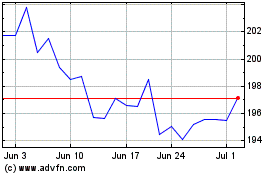Nymex Trading Pits Shut Down, Marking End of an Era
December 29 2016 - 12:21PM
Dow Jones News
By Alexander Osipovich
The open-outcry trading floor of the New York Mercantile
Exchange in lower Manhattan will shut down after markets close
Friday, the latest step in the inexorable shift toward electronic
trading.
CME Group Inc., which owns the Nymex, said in April that the New
York trading floor would close at the end of the year after the
share of options volume executed there had dwindled to just 0.3% of
the company's overall energy and metals volumes. Chicago-based CME
had already stopped futures trading on the Nymex floor last
year.
Though long expected, the closure of the 25,000-square-foot
Nymex floor has instilled nostalgia in traders who remember its
heyday, when more than 1,000 people crowded into its pits to shout,
jockey for position and arrange trades through an arcane language
of hand signals.
"It was like going to the Super Bowl every day for work," said
David Greenberg, a former Nymex board member and veteran of the
crude oil and gold pits.
Some vestiges of that culture will live on in a "Trading Annex"
that CME set up for displaced floor traders and brokers. About 70
of them have agreed to trade electronically out of booth-like
spaces in the Nymex building while retaining their status as
registered floor brokers or traders, a CME spokeswoman said.
The Nymex dates back to the founding of the Butter and Cheese
Exchange of New York in 1872. It became best known for energy
trading after the launch of oil futures in 1983, and in 1994 it
merged with the Comex, which focused on precious metals.
In their glory days, the New York commodities exchanges were a
magnet for ambitious young men looking to make it rich, including
many from working-class families, veteran traders recall.
Fistfights sometimes broke out on the floor, and unlike at the
elite banks, it didn't take a college degree to get a trading
job.
"Commodities were the other side of the tracks," said Michel
Marks, the Nymex's chairman from 1978 to 1987.
Technology eventually doomed the floor. A turning point came in
September 2006, when the Nymex allowed electronic trading during
the same hours as open-outcry, after years of resistance from floor
traders. The share of futures trades executed in the pits fell
drastically afterward.
The Nymex's slow response to the rise of electronic trading was
among the factors that led to its acquisition by CME in 2008.
Options continued to be a bastion of floor trading, due to the
difficulty of executing complex options trades through a computer.
As late as 2012, nearly half the volume in Nymex options was still
done through open outcry, CME data show.
Some longtime traders say the shift to screen trading had its
drawbacks. George Gero, managing director at RBC Wealth Management,
said the floor made it possible to sense the collective mood of the
market and relay it to clients -- an impossibility in today's
faceless electronic markets.
"It's a loss for the markets because the human input was
sometimes very good for guiding customers," said Mr. Gero, who
first bought a seat at the Nymex in 1964 and started out trading
platinum and palladium futures.
Others counter that electronification slashed costs and made
markets fairer and more efficient.
"Good riddance to open outcry," John Arnold, the billionaire
former chief executive of natural-gas hedge fund Centaurus Energy,
said in an email to The Wall Street Journal. "The transition from
open-outcry to electronic trading happened so quickly because it
provided far superior execution to the customer."
Floor traders sometimes sparked resentment because their
positions in the pits gave them immediate access to market-moving
information. A fear among firms outside the clubby Nymex community
was that their buying and selling of futures would be undermined by
those at the exchange, who would catch wind of incoming
transactions and trade against them.
"It never struck me as the most brilliant system," said Nigel
Saperia, a retired oil trader who worked at firms including Royal
Dutch Shell PLC. "It was way too easy for [traders in the pits] to
make money."
There were cases of outright wrongdoing. In April 2008, a former
Nymex board member pleaded guilty to fraud in connection with
criminal allegations that he had allocated profitable orders to
himself and money-losing orders to his customers.
Exchanges still operate a small number of trading floors around
the country. The best known is perhaps the New York Stock
Exchange.
CME still has open-outcry pits in Chicago for financial
contracts such as S&P 500 futures, as well as options on
soybeans, wheat and other agricultural commodities. There are no
plans to close the Chicago trading pits, the CME spokeswoman
said.
Write to Alexander Osipovich at
alexander.osipovich@dowjones.com
(END) Dow Jones Newswires
December 29, 2016 12:06 ET (17:06 GMT)
Copyright (c) 2016 Dow Jones & Company, Inc.
CME (NASDAQ:CME)
Historical Stock Chart
From Mar 2024 to Apr 2024

CME (NASDAQ:CME)
Historical Stock Chart
From Apr 2023 to Apr 2024
